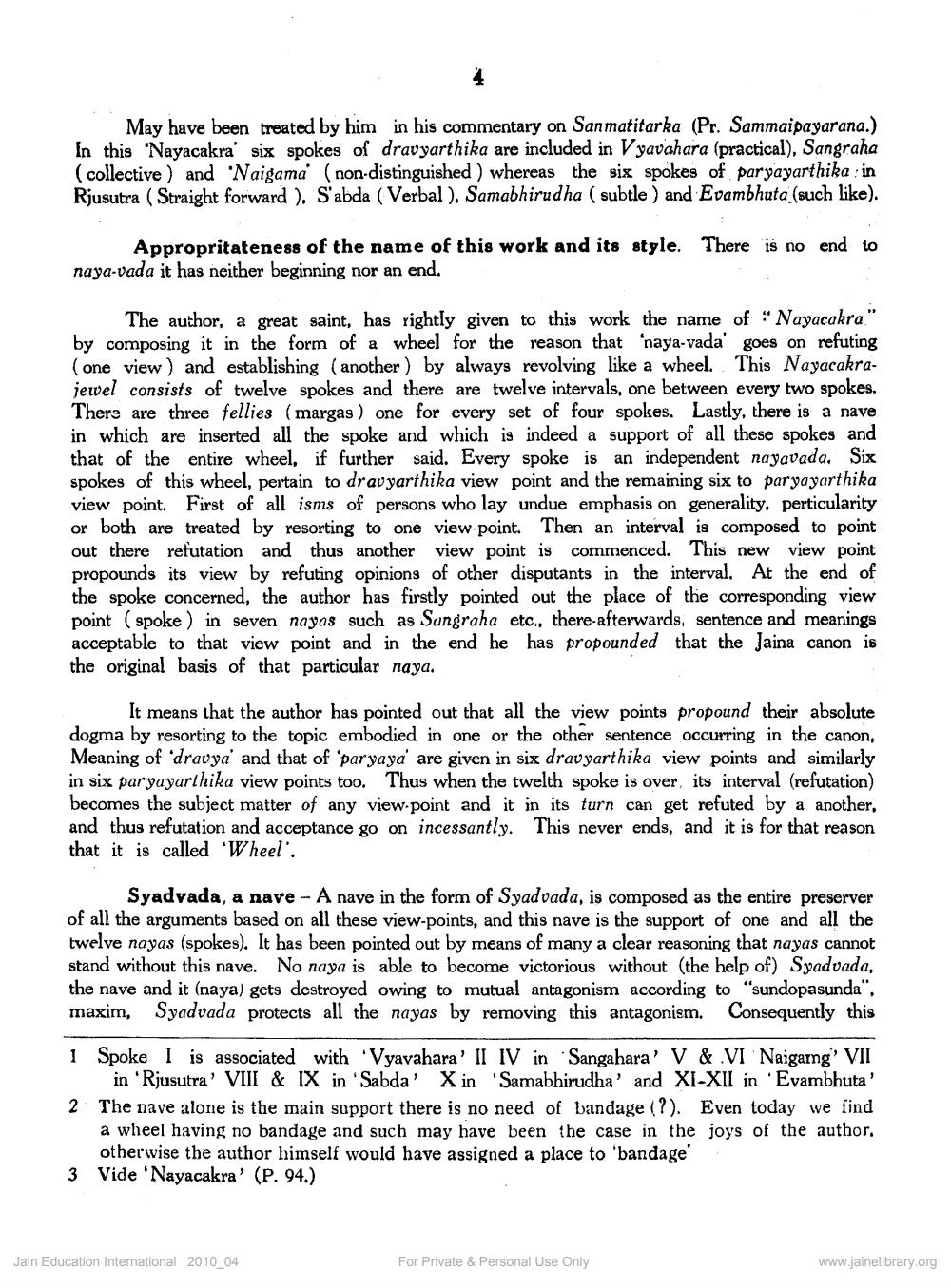________________
May have been treated by him in his commentary on Sanmatitarka (Pr. Sammaipayarana.) In this 'Nayacakra'six spokes of dravyarthika are included in Vyavahara (practical), Sangraha (collective) and 'Naigama (non distinguished) whereas the six spokes of paryayarthika in Rjusutra (Straight forward ). S'abda (Verbal), Samabhirudha ( subtle ) and Evambhuta (such like).
Appropritateness of the name of this work and its style. There is no end to naya-vada it has neither beginning nor an end.
The author, a great saint, has rightly given to this work the name of Nayacakra." by composing it in the form of a wheel for the reason that 'naya-vada' goes on refuting (one view) and establishing (another) by always revolving like a wheel. This Nayacakrajewel consists of twelve spokes and there are twelve intervals, one between every two spokes. There are three fellies (margas) one for every set of four spokes. Lastly, there is a nave in which are inserted all the spoke and which is indeed a support of all these spokes and that of the entire wheel, if further said. Every spoke is an independent nayavada. Six spokes of this wheel, pertain to dravyarthika view point and the remaining six to paryayarthika view point. First of all isms of persons who lay undue emphasis on generality, perticularity or both are treated by resorting to one view point. Then an interval is composed to point out there refutation and thus another view point is commenced. This new view point propounds its view by refuting opinions of other disputants in the interval. At the end of the spoke concerned, the author has firstly pointed out the place of the corresponding view point (spoke ) in seven nayas such as Sangraha etc., there-afterwards, sentence and meanings acceptable to that view point and in the end he has propounded that the Jaina canon is the original basis of that particular naya,
It means that the author has pointed out that all the view points propound their absolute dogma by resorting to the topic embodied in one or the other sentence occurring in the canon, Meaning of 'dravya' and that of 'paryaya' are given in six dravyarthika view points and similarly in six paryayarthika view points too. Thus when the twelth spoke is over, its interval (refutation) becomes the subject matter of any view.point and it in its turn can get refuted by a another, and thus refutation and acceptance go on incessantly. This never ends, and it is for that reason that it is called 'Wheel'.
Syadvada, a nave - A nave in the form of Syadvada, is composed as the entire preserver of all the arguments based on all these view-points, and this nave is the support of one and all the twelve nayas (spokes). It has been pointed out by means of many a clear reasoning that nayas cannot stand without this nave. No naya is able to become victorious without (the help of) Syadvada, the nave and it (naya) gets destroyed owing to mutual antagonism according to "sundopasunda", maxim, Syadvada protects all the nayas by removing this antagonism. Consequently this
1 Spoke I is associated with Vyavahara' II IV in Sangahara' V & VI Naigamg'' VII
in 'Rjusutra' VIII & IX in 'Sabda' X in 'Samabhirudha' and XI-XII in Evambhuta' 2 The nave alone is the main support there is no need of bandage (?). Even today we find
a wheel having no bandage and such may have been the case in the joys of the author.
otherwise the author himself would have assigned a place to 'bandage 3 Vide 'Nayacakra' (P. 94.)
Jain Education International 2010_04
For Private & Personal Use Only
www.jainelibrary.org




